|
It's
hard to put into words the genuine shock to the system that
Gasper Noé's now notorious Irréversible
delivers. There may well be a fair number of you out there
who have never seen it and even a few who have never heard
of it. There are also, I would imagine, a sizeable number who
know all about it and have no wish to watch it, and probably
just as many who have seen it once and have no desire to
sit through it a second time. I can understand that.
I have friends for whom extreme cinema is part of their
staple diet but who shake their heads and suck air through
their teeth when you bring up Irréversible.
For
the few of you who are new to the film, Irréversible
is reverse-structured rape/revenge story, a new take on
a sub-genre that regularly attracts charges
of exploitation, which is hardly surprising given that two of its most
famous torch-bearers are Wes Craven's 1972 The Last
House on the Left and Meir Zarchi's 1978 I
Spit on Your Grave. But if Zarchi's film is often cited as the genre's nadir, Craven's is generally regarded as
a deeper work than the surface horror suggests and was
actually a partial remake of Ingmar Bergman's 1960 The Virgin
Spring, perhaps the unwitting godfather of a subgenre
that Bergman himself would doubtless have shuddered at the
idea of being even tentatively associated with. Balancing exploitation with more
serious concerns has been the difficulty for any filmmaker
wandering into this morally dubious area, from Sam Peckinpah's
1971 Straw Dogs to Abel Ferrera's 1981
Ms. 45 and Tony Garnett's 1983 Hand
Gun. All have their enthusiastic supporters but
also a number of very vocal detractors, and it's easy to see why
– the victims are usually female, the filmmakers male, and
any trivialisation of a crime as wretched as rape usually
deserves every brickbat thrown at it. That few of us have
the same reaction to on-screen murder perhaps (and I do
mean perhaps, as I know there are other factors at work here) says
more about its cinematic frequency than it does about how
seriously we regard the act itself.
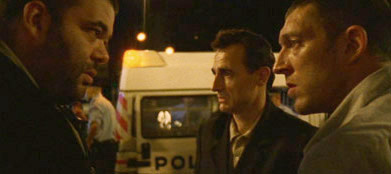
If
opinion was divided on the above named films, then it was complete
polarised by Gasper Noé's Irréversible.
Noé himself is no stranger to controversy – the central
character of his 1998 debut feature Seul contre
tous was a sexist
and racist homophobe whose spleen-venting monologues and
brutal assault on his pregnant wife make him one of the most unlovable
anti-heroes in modern cinema. Irréversible sparked an even deeper critical divide, accusations
of attention-grabbing exploitation and a childish determination
to shock at all costs going head-to-head with praise for
the film's daring, intelligence and thunderous power. This
battle of opinions was given lucid voice in the February
2003 issue of Sight & Sound, in which critics
Nick James and Mark Kermode justified in some detail their
opposing standpoints on the film.
So what exactly is the problem here? The debate, for those
who do not know, revolves largely around two genuinely horrifying
key scenes. The first occurs just minutes into the film, when a man has his head beaten
to a bloody pulp with a fire extinguisher, an assault whose
extended viciousness goes way beyond its initial purpose
of instinctive retaliation for violence inflicted
on the attacker's friend. The first blow sees to that –
the subsequent twenty-one are about something else entirely.
The film then shows us the immediate build-up to this moment. We know little about any of the characters at this point,
save that two of them are urgently searching a demonically
lit gay nightclub known as Le Rectum for a man nicknamed
Le Tenia. When the more aggressive of the pair angrily confronts
the man he believes is the object of his search, a fight
breaks out and he is pushed to the floor and his arm is
broken. He is on the verge of being raped when his seemingly
more reluctant companion steps in and does extreme violence.
If
you don't know at the start (and few will approach the film
without some foreknowledge of this), then it won't be long
before you realise that what immediately follows is not a flashback to clarify the
opening attack, but the next sequence in a reverse narrative
of the sort made famous by Christopher Nolan's Memento.
In the manner (but definitely not the style) of a news report,
we stumble onto an incident whose back story is gradually
revealed through cinematic investigation. The guy with the
broken arm is Marcus, and he's riding on fury – on his way
to the club he assaults a taxi driver, loses his rag in
a café and smashes the windows of a car to stop his
friend Pierre from driving off and leaving him. Pierre is
increasingly revealed as a somewhat unwilling accomplice,
repeatedly trying dissuade his angry companion from doing
anything rash. "What's your anger about?" he asks
him. "Fucking B-movie revenge crap!"
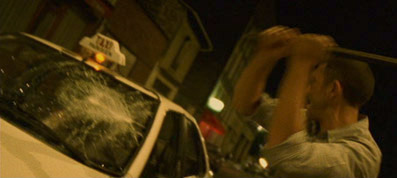
We're
quite a way back into the story when we get the first real
window into the source of Marcus's fury. Someone has been
raped, we are told, and it's clearly someone he knows well.
Another hop backwards and we find the two men in shock,
reacting to what we (and they) have yet to witness and being
propositioned by a local gangster who calmly assures Marcus
that "until proof to the contrary, I can be your best
friend." This new friend knows the name of the man
who committed the crime that they are so shaken by, and
for a fee promises to help make him suffer. Hop back again
and Marcus and Pierre are still happy, but not for long
– they emerge from a party and almost immediately encounter
the end result of the incident that will set them on the
path to vengeance. By now we know the nature of the crime
and have seen its terrible consequences. Are we apprehensive?
You don't know the half of it.
As
the next jump back begins, the camera follows an
unidentified woman down into a red-walled subway, and there
will be few who will not fear what is to follow. And I can
pretty much guarantee that it's far worse than anything
you will imagine or expect. This scene has been the key
focus of discussion, disagreement and audience horror since
the film first screened at Cannes back in May 2002, and
I would imagine at least partly responsible for its reputation
as one of the most walked-out-of movies in modern cinema
– two hundred got up and left during the Cannes screening alone.
It is, without question, an almost unbearable scene to watch,
as a repulsively brutal rape that is shown in its entirety
and in real time as a single, static shot held for agonising
length, and is followed by a beating violent enough to make
even the most hardened viewer recoil.
The argument against the film can certainly be said to have
ammunition here. On the surface at least, this does appear to be designed purely
to out-shock everything that even extreme cinema has given us before, guaranteeing
the film the sort of press coverage that will find it an
audience based on the controversy alone. And, of course, there's the
gimmick of the backward running narrative, and I haven't
even mentioned the wild, disorientating camerawork and the
anxiety-inducing soundtrack. Exploitation cinema at its
most unredeemable, then? It's certainly an easy case to
make based on the evidence as listed, but to do so entails
shutting your eyes, ears and intellect to Noé's clear
sense of purpose, and to the film's very considerable achievement
both as drama and as cinema.
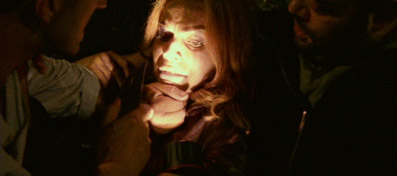
The
reverse narrative structure is purposefully employed, inverting the usual dramatic set-up of introducing
the characters first and the narrative disruption later,
and in the process undermining the standard structure of the rape/revenge
subgenre itself. Here revenge provides no visceral thrills
or moral satisfaction because we have no emotional investment in
the characters at this stage. Later, we can look back and
perhaps feel that Le Tenia got what he deserved, but you
don't get to enjoy the vengeance in the usual manner, and
a second viewing reveals that's it's not him that takes
the beating anyway but an unfortunate associate, one whose murder Le Tenia
watches and appears to enjoy.
If
the rape itself is sickening to watch then it damned well
should be, and though you'll want to turn your head away, you shouldn't.
It has been suggested that men find the scene even more
unbearable than women, as they are forced into the situation
of identifying completely with the female victim and understanding
just something of the sheer awful horror of what it is to
be so assaulted (the gender barrier to identification is
further destroyed by the nature of the attack itself, which
could just as easily have been inflicted on a man). So unwavering
is the camera's stare, so real does Alex's suffering feel,
that we as an audience become inevitably complicit, unable
to intervene, to respond to the hand that reaches out desperately
for our help. I swear you'll never hear the word 'rape'
again without recalling this scene, and you'll never hear
it taken lightly again by anyone without wanting to subject
them to the Ludovico Treatment with this sequence as the
medicine.
The
camera at times feels chained to the emotional condition
of the characters it observes, the frantically mobile, almost
unframed insanity of Marcus and Pierre's arrival at Le Rectum
settling down over the course of the film to an eventual
stedicam calm as we and they are transported back to less troubled times.
Elsewhere it echoes the rhythm of an anguished heartbeat,
or drifts around rooms or between locations like a half-formed
memory, an experience captured only in essence rather than
in fine detail.
The
editing is largely invisible, the impression being of a
film told in a single wandering shot, short chapters digitally
linked to allow the camera to fly between moving vehicles,
and in and out of closed windows like a curious insect.
The aplomb with which the camera operator (usually Noé
himself) and the actors pull off the largely unscripted ten
to fifteen minute sequences is quietly mesmerising. The
most complex of shots is so casually executed that it's
only afterwards that you realise that we have followed the
three leads down into a Metro station, onto a train and
three stops down the line to their destination in one unbroken
ten minute take, with them confidently and entertainingly
improvising dialogue the whole way. Sound
plays an equally important role in grinding the opening
scenes into the brain, a single electronic chord that builds
in volume and intensity and is underscored by low frequency rumble
pitched at 27hz, the sort of half-audible tone that has
been proven to induce anxiety and even nausea in those who
hear it. Used in some countries by riot police
to disperse crowds, this technique has been credited with
as many walkouts as the rape scene.
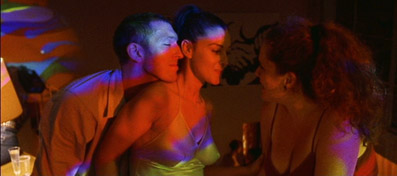
By
inverting the narrative, Noé robs the film of a traditional
climactic scene, instead providing a compelling backward journey
from darkness into light, a serenity that is nonetheless
tarnished by the foreknowledge of the fate that is soon
to befall characters we by then know and care for. Twice we
are told that "time destroys all things," a truism
of the cycle of nature that is here robbed of the optimism
of rebirth and evolutionary progression. Or is it? The narrative structure
suggests that the future is already written and that we
are prisoners of fate, and your response to the ending will
depend on whether you share this viewpoint. I do not. The
very idea of a pre-determined future absolves everyone of
responsibility for their actions and makes a mockery of
free will and even the wonders of chance, and chance is as much responsible
for Alex's fate as malicious intent. With that in mind, and
with infinite possibilities for any future, the ending of Irréversible can be seen to shine
a ray of hope on its own searing vision of a dark and unpleasant
world.
There
may still be issues to answer here, not least what could
be read as homophobic overtones (Noé's cameo as a
masturbating man in Le Rectum is reportedly due to his own
concerns over this possible perception), but in the great
debate over Irréversible's merits
or otherwise, I am fully prepared to shout in its support.
Although as difficult and challenging a film as you'll find
on DVD anywhere at the moment, it's also a bold, fiercely
performed and brilliantly executed work that genuinely assaults
the senses and, for those with the stamina to see it through,
really does reward the intellect.
Shot
on Super-16 and transferred to High definition video for
scope reframing and effects work, the picture was always
going to display a certain amount of grain and it's very
visible here, but it also works fine for the film's initially
demented aesthetic. Contrast and black levels are bang on,
the lost-in-the-dark arrival at Le Rectum clearly intended
to be disorientating and unclear. The very specific colour
palette also comes across well, though the use of dark red tints
works better in a darkened room than in bright sunshine.
A fine transfer that is framed 2.35:1 and enhanced for widescreen
TVs.
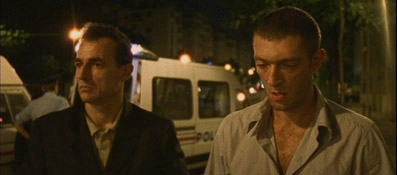
The
usual Tartan trio of soundtracks are on offer, but good
though the stereo 2.0 is, 5.1 and DTS are the only way to
go if you want to experience the full effects of Thomas Bangalter's
music and Noé's
genuinely unsettling use of low frequency rumbles. A terrific soundtrack that is organically integrated
to the visuals and the emotions of the characters, providing
a genuinely nightmarishly audio-visual experience.
One
thing the original region 1 release always had over its
UK cousin was a commentary by director Gasper Noé.
Now Tartan have gone one better in this new Collector's
Edition with a director and cast commentary,
featuring Noé and actors Monica Bellucci and Vincent
Cassel. Not bad, huh? Except that despite this claim on the extras menu, that's not we we get. Noé
is certainly on board and has plenty to say, but there is
no sign of Bellucci or Cassel, a damned shame when you consider
how interesting Bellucci's views and memories of filming the rape scene would have
been. But this blip should
not count as a deciding factor on whether to buy, as Noé
is so bristling with information that I did not for a second
feel short-changed. He discusses his influences, the cast,
the soundtrack, the filming of specific sequences, the ingenious
use of digital effects (this was especially eye opening)
and a whole lot more. It's an essential and consistently
enthralling companion to the film.
SFX
(7:12) is a short featurette of the digital effects work
done for the film by visual effects studio Mac Guff, and
based around an interview with effects man Rodolphe Chabrier.
Plenty of before-and-after examples are included, and it
makes for very revealing and fascinating viewing. I could
have done with more on this.
Intoxication (4:56) is an interview with director Stéphane Druout,
who appears in the opening scene opposite Philippe Nahon
(replaying his character from Noé's Seul
contre tous). There's a melancholy feel to the
chat, which is conducted in Druout's dingy kitchen to the sound of
rainfall and kicks off with him taking medication
to help him cope with the symptoms of AIDS.
Stress
(4:32) and Outrage (4:24) are
music videos made up of drifting hand-held footage from
two of the film's locations, set to electronic tracks by
Thomas Bangalter, half of Daft Punk and the man responsible
for the film's score.
Teasers
(3:09) consists of 6 short teaser trailers, three of them
semi-abstract, one a little misleading and two that point
you in the right direction.
The
Trailer (1:42) is well assembled,
but doesn't provide any real warnings of things to come.
Many
will already have made up their minds about Noé's
film, and if you hated it then I concede that none of the
above is likely to persuade you to take another look. If
you haven't seen it then you should by now at least be aware
of the horrors that lie ahead and will approach it with
your eyes open (if you can keep them that way during the
strobe lighting assault at the very end, you might just find
yourself twitching on the floor). For those who already
appreciate Noé's considerable cinematic achievement,
then Tartan's re-release really delivers. The picture is
good, the soundtrack brain-rattling, and although the actors
are absent from the commentary, it's hard to imagine that
Noé would have let them get a word in anyway. Highly
recommended, but with the obvious warnings.
|